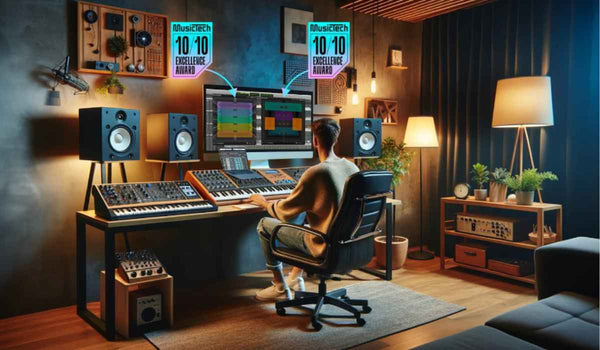
How to EQ Ukuleles to Sound Pro
Share
How to EQ Ukuleles to Sound Pro
Introduction
The ukulele, with its mellow tones and cultural charm, has surged in popularity over the past few years. It's no longer just an instrument for traditional Hawaiian music; it has found its way into almost every genre, from pop and rock to indie and folk. Achieving a professional mix for ukulele recordings, however, presents unique challenges. The instrument's distinct sonic characteristics require a nuanced approach to equalization (EQ) and sound design.
In this guide, we'll delve into how to elevate your ukulele recordings using Mastering The Mix’s innovative plugins, MIXROOM and RESO. These tools are not just for seasoned pros; even if you're at the beginning of your music production journey, understanding and applying the principles here can transform the sound of your ukulele from merely good to truly professional.
Let's explore:
- The unique acoustic characteristics of the ukulele.
- Common EQ challenges in mixing ukulele tracks.
- Solutions that MIXROOM and RESO provide to enhance your mix.
By the end of this guide, you'll have the knowledge and tools to not only correct common mixing issues but also to accentuate the natural beauty of the ukulele, ensuring your recordings stand out in the best way possible. Whether you're aiming to add a tropical vibe to your tracks or simply enrich your musical palette, mastering the mix of a ukulele can add an extraordinary layer of depth to your productions.

Understanding the Ukulele's Frequency Range
The ukulele, with its cheerful and harmonic sound, occupies a unique place in the frequency spectrum. Understanding this instrument's frequency range is vital to achieving a clean and professional mix. The ukulele typically spans a range from approximately 250 Hz to over 2 kHz, with its most vibrant tonal qualities lying within this spectrum.
Here are some common issues and focal points in the ukulele's frequency range:
- Muddiness can occur around 250-500 Hz, where too much energy results in a lackluster, undefined sound.
- The body and warmth of the ukulele are often found in the 500-1 kHz range, needing careful balancing to avoid overpowering the mix.
- Clarity and presence shine through between 1-2 kHz, vital for ensuring the ukulele sits well in the mix without competing with vocals or other lead instruments.
- The sparkle and airiness that give the ukulele its characteristic brightness are found above 2 kHz.
These areas each play a crucial role in how the ukulele is perceived in a mix. Addressing issues within these ranges requires a detailed and surgical approach to EQ. Without careful adjustments, there's a risk of either masking the ukulele's charm or making it sound harsh and disconnected from the rest of the track.
In the next sections, we'll explore how MIXROOM and RESO can be invaluable tools in navigating these challenges, helping you enhance the ukulele's natural beauty while ensuring it blends seamlessly with your overall mix.
The Role of EQ in Mixing Ukuleles
Equalization is a pivotal tool in the audio production process, especially when it comes to instruments like the ukulele that offer a rich harmonic content within a constrained frequency range. The goal of EQing a ukulele is to enhance its natural beauty, mitigate any frequency-related issues, and ensure it sits perfectly within the mix. Here, balance and separation emerge as key themes:
- Balance: Attaining a harmonious relationship between the ukulele's warm body and its bright, sparkling highs.
- Separation: Ensuring the ukulele has its own clear space in the mix without clashing with other instruments or the vocals.
To achieve these, focus on the following frequency adjustments:
- Reducing Muddiness: Apply a high-pass filter starting around 200-250Hz to remove unnecessary low-end rumble.
- Enhancing Warmth: Boost slightly around 500-1kHz to bring out the ukulele's body and warmth, being mindful not to muddy the mix.
- Clarity and Presence: A gentle boost in the 1-2kHz range can enhance articulation and presence, making the ukulele more distinct.
- Airiness: To give the ukulele a sense of air and sparkle, consider a slight boost above 5kHz, carefully avoiding harshness.
While EQing, the key is subtlety. Over-EQing can quickly lead to an unnatural sound, stripping away the ukulele's inherent musicality. Instead, aim for slight adjustments that respect and highlight the instrument’s acoustic properties.
In the following section, we'll explore how the MIXROOM plugin can streamline this process, offering intuitive and precise control over your EQ decisions, specifically tailored to enhance the ukulele's role in your mix.

Using MIXROOM for Precision EQing
MIXROOM by Mastering The Mix is a powerful EQ plugin designed to offer producers intuitive and precise control over their mixing decisions. Its intelligent features are especially beneficial for instruments like the ukulele, requiring a detailed approach to EQing. Here’s how you can use MIXROOM to elevate your ukulele tracks:
Step 1: Identify Key Frequencies
- Load MIXROOM on your ukulele track within your DAW.
- Use the Target feature to select a preset that closely matches the characteristic of your ukulele track, or create a custom target based on your mix’s needs.
- Play the ukulele track and observe the real-time spectral analysis. MIXROOM will highlight areas that might need attention, offering a visual guide for your EQ decisions.
Step 2: Apply Surgical EQ Adjustments
- High-Pass Filtering: Start with a high-pass filter to remove low-end rumble, setting the cutoff point where the graph indicates minimal musical content.
- Addressing Muddiness: Look for peaks between 250-500Hz. Use narrow Q values to surgically reduce any overbearing frequencies without impacting the warmth of your ukulele.
- Enhancing Clarity: Identify areas within 1-2kHz where the graph suggests a lack of presence. Boost these slightly to improve articulation.
- Adding Sparkle: For airiness, apply a gentle shelf boost above 5kHz, watching the graph to ensure you’re not introducing harshness.
Step 3: A/B Testing and Refinement
- Utilize MIXROOM’s A/B feature to compare your EQed track against the original.
- Adjust your settings based on a direct comparison, honing in on a sound that complements your mix while preserving the natural tone of the ukulele.
With MIXROOM, the complexities of EQing a ukulele become manageable. Its guided approach ensures that even producers new to EQ can make informed decisions, enhancing their ukulele tracks to professional standards with confidence and precision.
In the next section, we’ll tackle resonance issues with the RESO plugin, further refining your ukulele’s sound in the mix.

Tackling Resonance with RESO
While EQ adjustments with MIXROOM can significantly enhance the mix, sometimes specific resonance issues can detract from the clarity and quality of a ukulele recording. Here, RESO from Mastering The Mix shines as a powerful tool specifically designed to identify and suppress unwanted resonances dynamically, ensuring your ukulele sounds as good as possible without any disruptive frequencies.
Identifying Problematic Resonances
- Insert RESO on your ukulele track after MIXROOM in your signal chain.
- Play your track and observe as RESO visually represents frequencies that are resonating excessively.
- Pinpoint specific frequencies that stick out adversely from the ukulele's natural harmonic balance.

Applying Dynamic Resonance Suppression
- Use RESO’s intuitive interface to select the frequencies highlighted.
- Adjust the depth of suppression to tastefully attenuate these resonances without stifling the ukulele's character.
- For broader concerns, utilize RESO’s band-width controls to manage the scope of suppression, ensuring a natural sound.
Refinement and Integration
- Fine-tune adjustments while continuously playing back the mix, focusing on achieving a balance where the ukulele sits perfectly among other instruments.
- Take advantage of RESO’s ability to dynamically respond to the music, ensuring that resonance suppression adapts with the changing notes and dynamics of your ukulele performance.
With RESO, subtlety is key. The goal is not to eliminate resonance entirely but to control it in a way that enhances the overall mix without sacrificing the natural sonic qualities of the ukulele. By attentively applying RESO’s dynamic resonance suppression, your ukulele tracks will gain an unmatched level of clarity and polish, ensuring they contribute positively to the final mix.
In the following section, we'll briefly touch on integrating other Mastering The Mix products to complement the ukulele mix, wrapping up our comprehensive guide to achieving professional ukulele sounds in your productions.
Integrating Other Mastering The Mix Plugins
While MIXROOM and RESO play pivotal roles in enhancing the ukulele’s presence in a mix, other plugins from Mastering The Mix can offer complementary benefits. Here’s how you can integrate additional tools to achieve a polished and professional sound:
Securing the Low-End with BASSROOM
- Even though ukuleles are not known for their low-end energy, ensuring that the lower frequencies are balanced is crucial for a well-rounded mix. BASSROOM can help sculpt the bottom end to ensure nothing overshadows the ukulele’s bright charm.
- Apply BASSROOM on the master bus or individual tracks that need clearer lower frequencies.
Ensuring Perfect Mix Levels with LEVELS
- Making sure your mix translates well across various listening environments is essential. LEVELS provides real-time visual feedback on key mixing parameters, ensuring your ukulele mix achieves both loudness and dynamic balance.
- Use LEVELS during the final stages of mixing to check for any inconsistencies and to ensure your track meets streaming platforms’ standards.
Each of these plugins brings unique strengths to your mix, helping to solve common mixing issues and refine overall sound quality. The ability to use them in conjunction with MIXROOM and RESO offers a comprehensive toolkit for addressing the intricacies of mixing ukuleles, ensuring your tracks are not only technically sound but also musically expressive.
Conclusion
Mastering the art of ukulele mixing is a journey of detailed adjustments and creative decisions. With the help of tools like MIXROOM, RESO, BASSROOM, and LEVELS, this journey becomes not only more manageable but truly enjoyable. Each plugin from Mastering The Mix offers an opportunity to dive deeper into the nuances of sound, enabling both budding and seasoned producers to achieve professional-quality mixes that make every ukulele recording shine.
Ready to elevate your ukulele tracks to the next level? Try a free trial of these plugins today and sign up for the Mastering The Mix newsletter for more tips, tricks, and insights. Your music deserves to be heard in the best light possible – let Mastering The Mix help you illuminate it.


